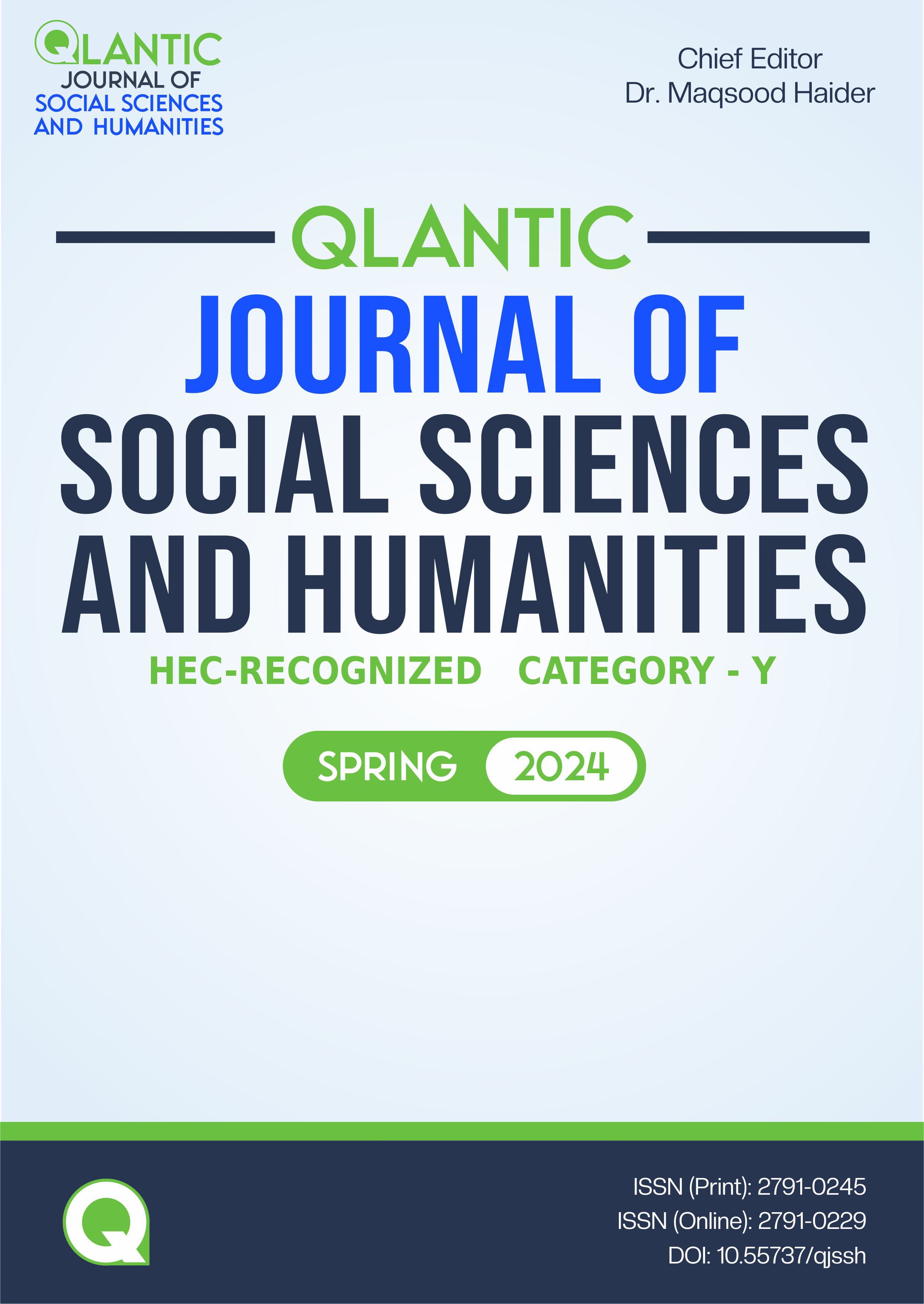Factors Influencing Women's Preferences for STEM Professions: A Case Study of the University of Peshawar
DOI:
https://doi.org/10.55737/qjssh.767391422Keywords:
Gender Disparity, Science, Technology, Engineering, Mathematics, Female, Male, Dominant Culture, Women's ParticipationAbstract
There is a widely held belief that there is an increasing gender gap in science, technology, engineering, and mathematics (STEM) worldwide. Women have achieved gender equality with men in certain professions, such as the humanities and social sciences. However, women still lack adequate representation in the highest positions of academia and the professional world in science, technology, engineering, and mathematics (STEM). This paper is grounded in institutional theory to explore the factors that demotivate or hinder women from joining STEM as a profession in universities. The research is based on a qualitative case study of the University of Peshawar. We conducted 20 interviews with female staff members in 13 STEM departments, with 32 female staff out of 183 faculty members. The collected data generated a total of 123 codes. The axial coding procedure generated 38 codes, which were grouped into fourteen distinct categories and four overarching themes of (1) male dominant culture, (2) multiple influences, (3) professional environment, and (4) job opportunities. The study highlights the complex interplay between societal attitudes and gender in STEM fields, emphasising the need for comprehensive strategies to promote gender equality. Addressing these factors and thoroughly analysing women's engagement in STEM departments is crucial.
References
Alam, A., & Tapia, I. S. (2020). Mapping gender equality in STEM from school to work. Technical Report. UNICEF Office of Global Insight and Policy. https://www.unicef.org/globalinsight/stories/mapping-gender-equality-stem-school work
Applewhite, A. (2002). Why so few women? IEEE Spectrum, 39(5), 65–66. https://doi.org/10.1109/6.999801
Blažev, M., Karabegović, M., Burušić, J., & Selimbegović, L. (2017). Predicting gender-STEM stereotyped beliefs among boys and girls from prior school achievement and interest in STEM school subjects. Social Psychology of Education, 20(4), 831–847. https://doi.org/10.1007/s11218-017-9397-7
Boll, C., & Lagemann, A. (2019). The Gender Pay Gap in EU Countries — New Evidence Based on EU-SES 2014 Data. Intereconomics, 54(2), 101–105. https://doi.org/10.1007/s10272-019-0802-7
Bryman, A. (Ed.) (2012). Social Research Methods (4th ed.). Oxford: Oxford University Press.
Charles, M., & Bradley, K. (2009). Indulging Our Gendered Selves? Sex Segregation by Field of Study in 44 Countries. American Journal of Sociology, 114(4), 924–976. https://doi.org/10.1086/595942
Charlesworth, T. E. S., & Banaji, M. R. (2019). Gender in Science, Technology, Engineering, and Mathematics: Issues, Causes, Solutions. Journal of Neuroscience, 39(37), 7228–7243. https://doi.org/10.1523/JNEUROSCI.0475-18.2019
Cole, S., & Zuckerman, H. (1984). The productivity puzzle: Persistence and change in patterns of publication of men and women scientists. Advances in Motivation and Achievement, 2, 217–258.
Else-Quest, N. M., Hyde, J. S., & Linn, M. C. (2010). Cross-national patterns of gender differences in mathematics: A meta-analysis. Psychological Bulletin, 136(1), 103–127. https://doi.org/10.1037/a0018053
Geertz, C. (1973). The Interpretation of Cultures: Selected Essays by Clifford Geertz. New York: Basic Books, Inc.
Makarem, Y., & Wang, J. (2019). Career experiences of women in science, technology, engineering, and mathematics fields: A systematic literature review. Human Resource Development Quarterly, 31(1), 91–111. https://doi.org/10.1002/hrdq.21380
Makarova, E., Aeschlimann, B., & Herzog, W. (2019). The Gender Gap in STEM Fields: The Impact of the Gender Stereotype of Math and Science on Secondary Students’ Career Aspirations. Frontiers in Education, 4(60). https://doi.org/10.3389/feduc.2019.00060
Malik, S., & Courtney, K. (2010). Higher education and women’s empowerment in Pakistan. Gender and Education, 23(1), 29–45. https://doi.org/10.1080/09540251003674071
McDool, E., & Morris, D. (2022). Gender differences in science, technology, engineering and maths uptake and attainment in post‐16 education. The Manchester School, 90(5), 473–499. https://doi.org/10.1111/manc.12403
Mehmood, S., Chong, L., & Hussain, M. (2018). Females Higher Education in Pakistan: An Analysis of Socio-Economic and Cultural Challenges. Advances in Social Sciences Research Journal, 5(6), 379–397. https://doi.org/10.14738/assrj.56.4658
Morley, L., & Crossouard, B. (2016). Women's Leadership in the Asian Century: Does Expansion Mean Inclusion? Studies in Higher Education, 41(5), 801-814. http://sro.sussex.ac.uk/id/eprint/59300/1/WHEL19Octclean-2.pdf
Nimmesgern, H. (2016). Why Are Women Underrepresented in STEM Fields? Chemistry - a European Journal, 22(11), 3529–3530. https://doi.org/10.1002/chem.201600035
North, D. C. (1990, October 26). Institutions, Institutional Change and Economic Performance. Cambridge University Press.
Pakistan Council for Science and Technology. (2013-14). Women Employment. http://www.pcst.org.pk/wst/wst_wemp.php
Qadir, F., Khan, M. M., Medhin, G., & Prince, M. (2011). Male gender preference, female gender disadvantage as risk factors for psychological morbidity in Pakistani women of childbearing age - a life course perspective. BMC Public Health, 11(1). https://doi.org/10.1186/1471-2458-11-745
Shehzad, R. S. (2020, August 23). PM approves STEM education project. The Express Tribune. https://tribune.com.pk/story/2260608/pm-approves-stem-education-project
Tabassum, N., & Nayak, B. S. (2021). Gender Stereotypes and Their Impact on Women’s Career Progressions from a Managerial Perspective. IIM Kozhikode Society & Management Review, 10(2), 192–208. sagepub. https://doi.org/10.1177/2277975220975513
Tacsir, E., Grazzi, M., & Castillo, R. (2014). Women in Science and Technology: What Does the Literature Say? Inter-American Development Bank.
Tamim, T. (2013). Higher education, languages, and the persistence of inequitable structures for working-class women in Pakistan. Gender and Education, 25(2), 155–169. https://doi.org/10.1080/09540253.2012.752793
Thibaut, L., Knipprath, H., Dehaene, W., & Depaepe, F. (2018). The influence of teachers’ attitudes and school context on instructional practices in integrated STEM education. Teaching and Teacher Education, 71, 190–205. https://doi.org/10.1016/j.tate.2017.12.014
Yin, R. K. (2018). Case Study Research: Design and Methods (6th ed.). Sage Publications.
Yousaf, R., & Schmiede, R. (2017). Barriers to women’s representation in academic excellence and positions of power. Asian Journal of German and European Studies, 2(1), 1–13. https://doi.org/10.1186/s40856-017-0013-6
Published
Issue
Section
License
Copyright (c) 2024 Qlantic Journal of Social Sciences and Humanities

This work is licensed under a Creative Commons Attribution-NonCommercial 4.0 International License.





